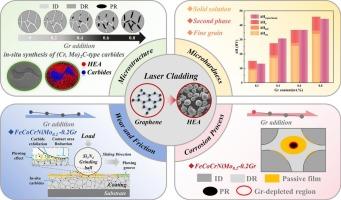Effects of in-situ synthesized carbides on microstructure and properties of FeCoCrNiMo0.2 / graphene composite coatings via laser cladding
IF 6.1
2区 材料科学
Q1 MATERIALS SCIENCE, COATINGS & FILMS
引用次数: 0
Abstract
The FeCoCrNiMo0.2 high-entropy alloy exhibits excellent corrosion resistance due to its ability to suppress the precipitation of σ phase, thus possessing enormous application potential in the field of corrosion-resistant coatings. However, its insufficient mechanical properties limit its application scope. This study reports a method to reinforce FeCoCrNiMo0.2 high-entropy alloy coatings by in-situ synthesizing M2C-type carbides through the addition of graphene via laser cladding technology. As the graphene content increases, the microhardness of the composite coating gradually rises. At 0.8 wt% graphene content, the coating achieved a peak microhardness of 254.6 HV0.5, representing a 21.1 % improvement over the HEA coating without graphene addition. Additionally, the wear resistance of the coating initially enhances, then decreases, and subsequently improves again with increasing graphene content. The optimal wear resistance occurred at 0.2 wt% graphene content, where wear volume decreased by 34.17 % compared with the HEA coating without graphene. However, the introduction of in-situ synthesized carbides compromises the integrity of the passive film and induces galvanic corrosion, leading to a gradual decline in corrosion resistance as graphene content increases. Notably, the coating with 0.2 wt% graphene maintained passive film integrity through repairable secondary passivation due to its fine carbide size. This work provides crucial insights into the mechanisms governing the influence of graphene-induced in-situ carbide synthesis on the microstructure and properties of HEA coatings.

原位合成碳化物对激光熔覆feccrnimo0.2 /石墨烯复合涂层组织和性能的影响
feccrnimo0.2高熵合金具有抑制σ相析出的能力,具有良好的耐蚀性,在耐蚀涂层领域具有巨大的应用潜力。但其力学性能不足,限制了其应用范围。本研究报道了一种通过激光熔覆技术原位合成m2c型碳化物增强FeCoCrNiMo0.2高熵合金涂层的方法。随着石墨烯含量的增加,复合涂层的显微硬度逐渐升高。在石墨烯含量为0.8 wt%时,涂层的峰值显微硬度为254.6 HV0.5,比未添加石墨烯的HEA涂层提高了21.1%。此外,随着石墨烯含量的增加,涂层的耐磨性先增强后降低,随后再次提高。当石墨烯含量为0.2 wt%时,HEA涂层的耐磨性最佳,与不含石墨烯的HEA涂层相比,其磨损体积减少了34.17%。然而,原位合成碳化物的引入破坏了钝化膜的完整性,引起电偶腐蚀,导致耐腐蚀性随着石墨烯含量的增加而逐渐下降。值得注意的是,含有0.2 wt%石墨烯的涂层由于其细小的碳化物尺寸,通过可修复的二次钝化保持了钝化膜的完整性。这项工作为石墨烯诱导原位碳化物合成对HEA涂层微观结构和性能影响的机制提供了重要的见解。
本文章由计算机程序翻译,如有差异,请以英文原文为准。
求助全文
约1分钟内获得全文
求助全文
来源期刊

Surface & Coatings Technology
工程技术-材料科学:膜
CiteScore
10.00
自引率
11.10%
发文量
921
审稿时长
19 days
期刊介绍:
Surface and Coatings Technology is an international archival journal publishing scientific papers on significant developments in surface and interface engineering to modify and improve the surface properties of materials for protection in demanding contact conditions or aggressive environments, or for enhanced functional performance. Contributions range from original scientific articles concerned with fundamental and applied aspects of research or direct applications of metallic, inorganic, organic and composite coatings, to invited reviews of current technology in specific areas. Papers submitted to this journal are expected to be in line with the following aspects in processes, and properties/performance:
A. Processes: Physical and chemical vapour deposition techniques, thermal and plasma spraying, surface modification by directed energy techniques such as ion, electron and laser beams, thermo-chemical treatment, wet chemical and electrochemical processes such as plating, sol-gel coating, anodization, plasma electrolytic oxidation, etc., but excluding painting.
B. Properties/performance: friction performance, wear resistance (e.g., abrasion, erosion, fretting, etc), corrosion and oxidation resistance, thermal protection, diffusion resistance, hydrophilicity/hydrophobicity, and properties relevant to smart materials behaviour and enhanced multifunctional performance for environmental, energy and medical applications, but excluding device aspects.
 求助内容:
求助内容: 应助结果提醒方式:
应助结果提醒方式:


